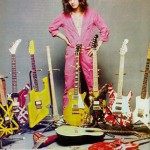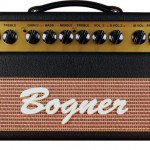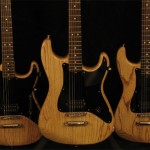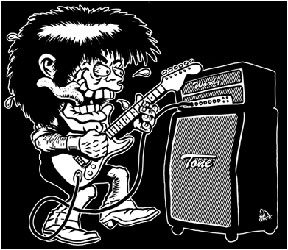Comp Lit, Pt. 2: Daddy Never Sleeps At Night
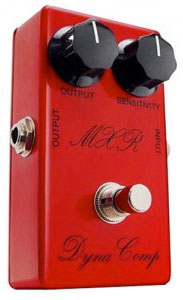 What a Compressor Can Do for You
What a Compressor Can Do for You
by John Drenning
Now we move on to how a compressor can help your playing and tone.
First, let’s say you want the advantages of playing with gain, but you need a clean tone. We all know playing with distortion is “easier” because distortion compresses your signal – but you can’t play the intro to “Stairway To Heaven” with the gain dimed on your Triple Rectifier (unless you want to be struck dead by a bolt of lightning).
Your solution: Compression, which like distortion, is a clam-eraser. It can push your signal enough to even things out without the hard clipping you get from amp distortion.
This also helps with funk-style chordal passages, where unless your picking technique is flawless, your dynamics will be all over the place. Think of Jamie West-Oram’s gem of a rhythm track on The Fixx’s “One Thing Leads To Another” (below). What makes that a perfect track is how consistent, how uninflected it is.
(I had long assumed he was just plugged right into the board, then run through an outboard compressor. Turns out he played it through either a Dyna Comp or a Valley People compressor, then used an MXR Stereo Chorus to split the signal to two Marshall JMP combos. So maybe Marshalls are versatile. And the guitar? Not a Strat – a p.o.s. Ibanez Blazer!)
West-Oram’s a great guitar player, but probably not great enough to be able to play every single chorded note and muted chikka-chikka at the exact same volume. A compressor does the heavy lifting of raising those quieter pick strokes and lowering the louder ones.
Second, when you’re playing in that in-between gain zone, a compressor can give your signal that little additional push. Not the this-one-goes-to-11 push (that comes later), just a bit more grit, which can also make the semi-dirty amp as forgiving to play through as a properly distorted amp. Take a slightly overdriven amp signal, push the output of the compressor a few degrees past unity gain to drive the amp a bit harder, and you’ve got the sustain and “give” of higher overdrive settings, but without all the dirt.
(“Unity gain” is the output setting on a compressor’s volume where your volume is the same when the compressor’s on as when it’s off. On a Dyna Comp, or most compressors for that matter, unity gain is a moving target: When you turn the Sensitivity knob up, the pedal gets louder, too.)
Guitarists like distortion because it’s a security blanket: Unless you’ve got the technique of Paco de Lucia and don’t need it, gain makes screw-ups harder to hear. A compressor gives you some of that blanket when you’re playing at less-than-gargantuan gain settings.
Third, a compressor can serve as the missing “11” on your amp’s volume knob. And who doesn’t want that! Of course, any pedal with an output or level knob can do this. You’re just using the pedal to boost the weedy signal generated by your guitar’s pickups, which then pushes the front end of your amp harder, making you sound more huge. Compressors are really good at this, since the two things they can do – make your guitar louder, and enhance sustain – are two things most guitarists aren’t going to be sad about. I never thought of a compressor as a “more” pedal until I put one in front of my aged JCM900, which I love but sometimes wish it had “more” – more girth, more gain, more sustain – the things that make an amp “forgiving.”
So if your cover band wants to blow the roof off that next casino gig when you’re covering “Time,” dime the output on that Dyna Comp! For single-coils especially, a compressor can be that much-needed sonic viagra to help you take it to the next level.
Sonic Penalties
Lest we end on a high note, let’s recall the words of Dr. Drew, who reminds us there’s no such thing as a free lunch. Compressors exact two sonic penalties. The first is noise. Since compressors raise the floor and lower the ceiling signal-wise, you can expect a lot more hiss when you’re not playing.
To mitigate this, try placing your compressor early in your signal chain, ideally right after your tuner and before any distortion or modulation effects. Conventional wisdom also places the compressor after the wah, but your mileage may vary.
You’ll find that the compressor makes other pedals work differently. I put my compressor before my tremolo pedal, and the compressor makes the trem sound completely different, which you’d expect, since compressors and tremolos are designed to do the exact opposite thing.
Of course, you can also kill the noise of a compressor with a good gate at the end of your signal chain (well, maybe before delay or reverb, but that’s another post) – just expect to raise the threshold of the gate a bit to account for the extra noise generated by the compressor.
The second sonic penalty is going to be a deal-breaker for some – for others, it’s the coolest thing about compressors: It’s the coloring (or “mangling,” if you will) a compressor adds to your signal.
When tone corksniffers talk about the “transparency” of an effect, basically they’re talking about the signal-to-noise ratio of that pedal. Take chorus, for example. The signal is the good part – it’s what coming out of your pickups, enhanced by the chorusing effect to have a pleasing aquatic swoosh. The noise (the bad part) is the extra hiss the chorusing adds, as well as any unwanted tonal shaping the chorus inflicts on your tone.
This analysis gets tricky because some people like the noise as much as the signal. Lo-fi chorus makes my eardrums bleed, but it worked out okay for Kurt Cobain.
Compressors do have various degrees of transparency. One example is the Keeley compressor, which I’ll take a look at in this series of posts, is prized for its transparency. But the reason the classic Dyna Comp has such a mighty sonic footprint is because it’s as transparent, and as subtle, as a cinder block. Party on!
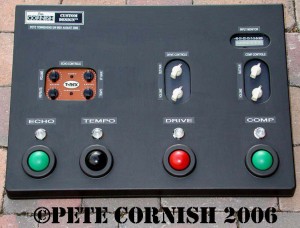
Pete Townshend's pedalboard, with T-rex Echo, Boss OD-1 and Demeter Comp-1 Compressor (click to see it bigger).
Coming soon:
Comp Lit, Pt 3: A review of the brand new Dunlop CSP202 Custom Comp compressor pedal.
Comp Lit, Pt 4: The Dunlop Custom Comp goes mano a mano with the Dyna Comp, Keeley and Diamond compressors.
During the day, John Drenning is a mild-mannered professional. But on his off hours he’s a tone fiend.
P.S.
Since everyone doesn’t read every post, will append posts with this for a bit. C’mon fellas!
Doing a “keep the lights on and do more cool sh*t” fund drive. If you dig and look forward to WoodyTone, and find the info fun and valuable, please frickin’ donate! Options for a one-time $20 or $5/mo below. Gracias amigos! Vamonos!
$20 one-time
$5/mo recurring
Category: Jamie West-Oram/The Fixx, Pete Townshend






